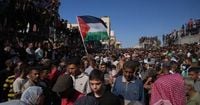In a week marked by both relief and renewed tensions, the fragile ceasefire between Israel and Hamas has been thrown into uncertainty following disputes over the pace of hostage returns and a consequential reduction in humanitarian aid to Gaza. The latest developments, confirmed by multiple international news agencies including the Associated Press and NewsNation, underscore the persistent volatility and human cost of the ongoing conflict.
On October 14, 2025, Hamas returned the bodies of four deceased hostages to Israel, a move facilitated by the Red Cross inside the Gaza Strip. This transfer followed the return of four other dead hostages just a day prior, according to the Israeli Prime Minister’s office. The remains were sent to the National Center for Forensic Medicine for identification before families were notified, a process that has become all too familiar for many Israelis since the onset of hostilities.
The return of these bodies was intended to ease mounting pressure on the ceasefire, but the Israeli military agency known as COGAT (Coordinator of Government Activities in the Territories) declared that the slower-than-expected pace of returns constituted a "violation" of the fragile truce. In response, COGAT announced plans to slash the number of humanitarian aid trucks allowed into Gaza by half—down to 300 from the 600 agreed upon under the ceasefire deal. This decision, relayed to the United Nations’ humanitarian office and U.S. officials, immediately raised concerns about the worsening humanitarian crisis in famine-stricken Gaza.
Olga Cherevko, spokesperson for the UN’s humanitarian office in Gaza, confirmed that word of the aid cuts had been received from the Israeli military agency in charge of transferring aid. U.S. officials were also notified of the change, according to three sources who spoke to the Associated Press on condition of anonymity. The reduction in aid comes at a time when Gaza’s civilian population is already facing dire shortages of food, water, and medical supplies.
U.S. President Donald Trump weighed in on the situation via social media, expressing concern that too few of the dead hostages had been returned. He issued a stern warning to Hamas, stating, “If they don’t disarm, we will disarm them.” Trump also emphasized that, in his view, the most challenging step—reaching a ceasefire agreement—was over, and that “rebuilding is maybe going to be the easiest part.” He further commented, “Gaza’s reconstruction requires that it be demilitarized and that a new honest civilian police force must be allowed to create a safe condition for the people in Gaza. As I said earlier, I intend to be a partner in securing a better future.”
The Hostages Family Forum, a grassroots organization representing many of the families awaiting news of their loved ones, expressed deep frustration with the slow return of deceased hostages. In a statement seen by the Associated Press, the group called the delay a “blatant violation of the agreement by Hamas.” Gal Hirsch, the Israeli official coordinating the return of hostages and missing persons, assured families in a note that international mediators were applying pressure on Hamas to expedite the process.
Meanwhile, the first phase of the ceasefire agreement had brought a measure of joy to both sides. On October 13, Israelis celebrated the return of the last 20 living hostages, while Palestinians rejoiced at the release of approximately 2,000 prisoners and detainees. For many families, however, the journey to recovery is just beginning. Dalia Cusnir-Horn described her brother-in-law Eitan Horn’s ordeal, noting he had lost more than 40% of his body weight during captivity. “He’s just learning now… friends he knew that were murdered, and he had no clue how many people were kidnapped on that day and what this country went through, and it’s overwhelming and it’s hard,” she told the Associated Press.
Palestinian prisoners released as part of the ceasefire have also reported severe mistreatment during their detention. Murad Barakat, medical director at the Palestine Medical Complex in Ramallah, said that several released men showed signs of having endured “severe beatings, reflecting the extent of the violence they endured,” according to resident doctor Imed al-Shami. Kamal Abu Shanab, who was released after more than 18 years, recounted, “For eight months, I wasn’t given even a pill for the pain.” While the Associated Press could not independently verify these claims, Israel’s Prison Service stated it was unaware of such allegations.
In Gaza, the situation remains grim. The Health Ministry reported that 45 Palestinian bodies had been transferred to the morgue at Nasser Hospital, the first of an expected 450. On the same day, the ministry said the bodies of three people killed by the Israeli military in the north were taken to Al Ahli hospital. The Israeli military stated that troops had “opened fire to remove the threat” of several people approaching and not complying with orders to stop. They did not immediately comment on any casualties. These incidents underscore the ongoing dangers facing Gaza’s civilian population, even as the ceasefire nominally holds.
Looking ahead, the question of Gaza’s future governance and reconstruction looms large. Egyptian Foreign Minister Badr Abdelatty announced that 15 Palestinian technocrats had been selected to administer Gaza, with approval from Israel, Hamas, and other Palestinian factions. Under the U.S.-brokered plan, an international body is expected to oversee Gaza’s administration and security, with the possibility of a future Palestinian state remaining a contentious issue. The United Nations Development Programme, in partnership with the European Union and the World Bank, estimated that rebuilding Gaza will require a staggering $70 billion.
Under the ceasefire deal, Israeli forces have pulled back to positions held in August 2025, though several hard-hit Palestinian neighborhoods remain under Israeli control. Israel has warned residents not to return to these areas, citing ongoing security concerns. Approximately 200 U.S. troops are currently stationed in Israel to monitor the ceasefire’s implementation and its aftermath.
The war has left a devastating toll: over 67,600 Palestinians killed, according to Gaza’s Health Ministry, with women and children making up around half the dead. While the ministry does not distinguish between civilians and combatants, many independent experts regard its figures as the most reliable estimate available.
As both sides grapple with the aftermath of violence and the uncertainty of what comes next, the human stories—of loss, resilience, and hope—continue to shape the region’s future. The coming weeks will test the durability of the ceasefire and the willingness of all parties to move beyond a cycle of retaliation toward a lasting peace.





